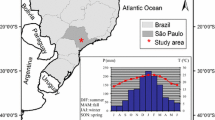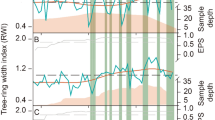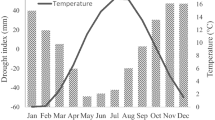Key message
Mexican Neotropical Symplocos species showed different wood anatomical climate adaptations and can help identify the effect of drought on relict-rare and endemic tree species.
Abstract
Neotropical montane oak forests are exceptionally biodiverse with rich assemblages of relict-endemic species promoting endemism hotbeds. These ecosystems are threatened by climate change, such as drought events and a decrease in fog and drizzle periods. We used dendroecological and wood anatomical tools to assess the effect of historical drought events on annual growth rings and vessel anatomical traits of Symplocos coccinea and S. speciosa, two rare relict-endemic tree species occurring in the Neotropical montane oak forest understory layer. Xylem vessel anatomical traits are essential for assessing and predicting tree–climate response to hydric availability. We analyzed vessel lumen area, diameter, and frequency in the growth rings developed in drought and non-drought years in both Symplocos species. We found that summer temperatures between May and August affect the annual growth. Finally, our analyses demonstrated that high xylem plasticity allowed rapid hydraulic architecture adjustments to drought events, suggesting an essential role of diffuse-porous wood in Neotropical trees to adapt to actual climatic variations. The studied chronologies allow reconstruction of climate variations in the Neotropical montane oak forest from eastern Mexico.







Similar content being viewed by others
Data availability
Data available on request from the authors.
References
Abrantes J, Campelo F, García-González I et al (2013) Environmental control of vessel traits in Quercus ilex under Mediterranean climate: relating xylem anatomy to function. Trees 27:655–662. https://doi.org/10.1007/s00468-012-0820-6
Aguilar-Rodríguez S, Terrazas T, López-Mata L (2006) Anatomical wood variation of Buddleja cordata (Buddlejaceae) along its natural range in Mexico. Trees 20:253–261. https://doi.org/10.1007/s00468-005-0007-5
Alcántara-Ayala O, Luna-Vega I (1997) Florística y análisis biogeográfico del bosque mesófilo de montaña de Tenango de Doria, Hidalgo, México. Anales Inst Biol Univ Nac Autón México Bot 68:57–106
Arenas-Navarro M, Oyama K, García-Oliva F et al (2021) The role of wood anatomical traits in the coexistence of oak species along an environmental gradient. AoB Plants 13:1–14. https://doi.org/10.1093/aobpla/plab066
Arlot S, Celisse A (2010) A survey of cross-validation procedures for model selection. Stat Surv 4:40–79. https://doi.org/10.1214/09-SS054
Barajas-Morales J (1985) Wood structural differences between trees of two tropical forests in Mexico. IAWA J 6:355–364
Bonan GB (2008) Forests and climate change: forcings, feedbacks, and the climate benefits of forests. Science 80(320):1444–1449. https://doi.org/10.1126/science.1155121
Borcard D, Gillet F, Legendre P (2011) Numerical ecology with R. Springer, New York
Bunn AG (2008) A dendrochronology program library in R (dplR). Dendrochronologia 26:115–124. https://doi.org/10.1016/j.dendro.2008.01.002
Carlquist S (1977). Ecological factors in wood evolution: a floristic approach. Am. J. Bot 64:887–896. https://www.jstor.org/stable/2442382
Cook ER, Holmes RL (1986) Guide for computer program ARSTAN. In: Users manual for program ARSTAN, in Tree-Ring Chronologies of Western North America: California, eastern Oregon and northern Great Basin. The international tree-ring data bank program library version, Arizona, pp 50–65
Cuapio-Hernández L, Sánchez-González A, Pavón-Hernández NP, López-Herrera M, Borja-de la Rosa MA (2022) Wood anatomy of Magnolia rzedowskiana Vázquez, Domínguez & Pedraza, endemic species of the Sierra Madre Oriental, Mexico. Rev Chapingo Ser Cienc for Ambiente 28:139–154
Engelbrecht BMJ, Comita LS, Condit R et al (2007) Drought sensitivity shapes species distribution patterns in tropical forests. Nature 447:80–82. https://doi.org/10.1038/nature05747
Fang J, Lechowicz MJ (2006) Climatic limits for the present distribution of beech (Fagus L.) species in the world. J Biogeogr 33:1804–1819. https://doi.org/10.1111/j.1365-2699.2006.01533.x
Fontes CG, Pinto-Ledezma J, Jacobsen A et al (2022) Adaptive variation among oaks in wood anatomical properties is shaped by climate of origin and shows limited plasticity across environments. Funct Ecol 36:326–340. https://doi.org/10.1111/1365-2435.13964
Fonti P, von Arx G, García-González I et al (2010) Studying global change through investigation of the plastic responses of xylem anatomy in tree rings. New Phytol 185:42–53. https://doi.org/10.1111/j.1469-8137.2009.03030.x
Fonti P, Heller O, Cherubini P et al (2013) Wood anatomical responses of oak saplings exposed to air warming and soil drought. Plant Biol 15:210–219. https://doi.org/10.1111/j.1438-8677.2012.00599.x
García-González I, Fonti P (2006) Selecting earlywood vessels to maximize their environmental signal. Tree Physiol 26:1289–1296. https://doi.org/10.1093/treephys/26.10.1289
Gareca EE, Fernández M, Stanton S (2010) Dendrochronological investigation of the high Andean tree species Polylepis besseri and implications for management and conservation. Biodivers Conserv 19:1839–1851. https://doi.org/10.1007/s10531-010-9807-z
Ghimire B, Park BK, Oh SH et al (2020) Wood anatomy of Korean Symplocos Jacq. (Symplocaceae). Korean J Plant Taxon 50:333–342. https://doi.org/10.11110/kjpt.2020.50.3.333
González-Espinosa M, Meave JA, Lorea-Hernández FG, Ibarra-Manríquez G, Newton AC (2011) The red list of Mexican cloud forest trees, 1st edn. Fauna & Flora International, Cambridge
Grissino-Mayer HD (2001) Evaluating crossdating accuracy: a manual and tutorial for the computer program COFECHA. Tree-Ring Res 57:205–221
Hacke UG, Sperry JS (2001) Functional and ecological xylem anatomy. Perspect Plant Ecol Evol Syst 4:97–115
Hacket-Pain AJ, Friend AD, Lageard JGA, Thomas PA (2015) The influence of masting phenomenon on growth-climate relationships in trees: explaining the influence of previous summers’ climate on ring width. Tree Physiol 00:1–12. https://doi.org/10.1093/treephys/tpv007
Hintze JL, Nelson RD (1998a) Violin plots: a box plot-density trace synergism. Am Stat 52:181–184. https://doi.org/10.1080/00031305.1998.10480559
Holwerda F, Bruijnzeel LA, Muñoz-Villers LE et al (2010) Rainfall and cloud water interception in mature and secondary lower montane cloud forests of central Veracruz, Mexico. J Hydrol 384:84–96. https://doi.org/10.1016/j.jhydrol.2010.01.012
Hostettler S (2002) Résumé forêts tropicales néphéliphiles de montagne: Un défi pour la conservation. Bois Forêts Des Trop 274:19–31
Jiménez-García D, Peterson AT (2019) Climate change impact on endangered cloud forest tree species in Mexico. Rev Mex Biodivers 90:1–14. https://doi.org/10.22201/ib.20078706e.2019.90.2781
Kapelle M (2006) Ecology and conservation of Neotropical montane oak forests, 1st edn. Springer-Verlag, Berlin
Kelly LM, Almeda F, Fritsch PW (2016) A taxonomic revision of Mexican and central American Symplocos (Symplocaceae). Phytotaxa 264:1–115. https://doi.org/10.11646/phytotaxa.264.1.1
Lourenço J, Enquist BJ, Arx G et al (2022) Hydraulic tradeoffs underlie local variation in tropical forest functional diversity and sensitivity to drought. New Phytol. https://doi.org/10.1111/nph.17944
Luna-Vega I, Alcántara-Ayala O, Espinosa D, Morrone JJ (1999) Historical relationships of the Mexican cloud forests: a preliminary vicariance model applying Parsimony Analysis of Endemicity to vascular plant taxa. J Biogeogr 26:1299–1305. https://doi.org/10.1046/j.1365-2699.1999.00361.x
Luna-Vega I, Alcántara-Ayala OA, Contreras-Medina R, Ponce-Vargas A (2006) Biogeography, current knowledge and conservation of threatened vascular plants characteristic of Mexican temperate forests. Biodivers Conserv 15:3773–3799. https://doi.org/10.1007/s10531-005-5401-1
Martínez-Cabrera HI, Cevallos-Ferriz SR (2008) Palaeoecology of the Miocene El Cien Formation (Mexico) as determined from wood anatomical characters. Rev Palaeobot Palynol 150:154–167. https://doi.org/10.1016/j.revpalbo.2008.01.010
Mooney CZ, Mooney CF, Duval RD, Duvall R (1993) Bootstrapping: a nonparametric approach to statistical inference. Sage Publications, Newbury Park
Oksanen J, Blanchet FG, Friendly M, et al (2016) Vegan: community ecology package. R Package version 2.4–1
Pearse IS, Koenig WD, Knops JMH (2014) Cues versus proximate drivers: testing the mechanism behind masting behavior. Oikos 123:179–184. https://doi.org/10.1111/j.1600-0706.2013.00608.x
Peel MC, Finlayson BL, McMahon TA (2007) Updated world map of the Köppen–Geiger climate classification. Hydrol Earth Syst Sci 11:1633–1644. https://doi.org/10.5194/hess-11-1633-2007
Ponette-González AG, Weathers KC, Curran LM (2010) Water inputs across a tropical montane landscape in Veracruz, Mexico: synergistic effects of land cover, rain and fog seasonality, and interannual precipitation variability. Glob Chang Biol 16:946–963. https://doi.org/10.1111/j.1365-2486.2009.01985.x
Poorter L, van der Sande MT, Arets EJ, Ascarrunz N et al (2017) Biodiversity and climate determine the functioning of Neotropical forests. Glob Ecol Biogeogr 26:1423–1434. https://doi.org/10.1111/geb.12668
Rahbek C, Borregaard MK, Antonelli A et al (2019a) Building mountain biodiversity: geological and evolutionary processes. Science 80(365):1114–1119. https://doi.org/10.1126/science.aax0151
Rauscher SA, Giorgi F, Diffenbaugh NS, Seth A (2008) Extension and Intensification of the Meso-American mid-summer drought in the twenty-first century. Clim Dyn 31:551–571. https://doi.org/10.1007/s00382-007-0359-1
Rita A, Cherubini P, Leonardi S et al (2015) Functional adjustments of xylem anatomy to climatic variability: insights from long-term Ilex aquifolium tree-ring series. Tree Physiol 35:817–828. https://doi.org/10.1093/treephys/tpv055
Rita A, Borghetti M, Todaro L, Saracino A (2016) Interpreting the climatic effects on xylem functional traits in two Mediterranean oak species: the role of extreme climatic events. Front Plant Sci 7:1–11. https://doi.org/10.3389/fpls.2016.01126
Rodríguez-Ramírez EC, Luna-Vega I (2020) Dendroecology as a research tool to investigate climate change resilience on Magnolia vovidesii, a threatened Mexican cloud forest tree species of eastern Mexico. In: Pompa-García M, Camarero JJ (eds) Latin American Dendroecology: combining tree-ring sciences and ecology in a megadiverse territory, 1st edn. Springer, Switzerland, pp 3–20
Rodríguez-Ramírez EC, Luna-Vega I, Rozas V (2018) Tree-ring research of Mexican beech (Fagus grandifolia subsp. mexicana) a relict tree endemic to eastern Mexico. Tree-Ring Res 74:94–107. https://doi.org/10.3959/1536-1098-74.1.94
Rodríguez-Ramírez EC, Terrazas T, Luna-Vega I (2019) The influence of climate on the masting behavior of Mexican beech: growth rings and xylem anatomy. Trees Struct Funct 33:23–35. https://doi.org/10.1007/s00468-018-1755-3
Rodríguez-Ramírez EC, Vázquez-García JA, García-González I, Alcántara-Ayala O, Luna-Vega I (2020a) Drought effects on the plasticity in vessel traits of two endemic Magnolia species in the tropical montane cloud forests of eastern Mexico. J Plant Ecol 13:331–340. https://doi.org/10.1093/jpe/rtaa019
Rodríguez-Ramírez EC, Valdez-Nieto JA, Vázquez-García JA et al (2020b) Plastic responses of Magnolia schiedeana Schltdl., a relict-endangered Mexican cloud forest tree, to climatic events: evidences from leaf venation and wood vessel anatomy. Forests 11:1–18. https://doi.org/10.3390/F11070737
Rozas V (2005) Dendrochronology of pedunculate oak (Quercus robur L.) in an old-growth pollarded woodland in northern Spain: tree-ring growth responses to climate. Ann for Sci 62:209–218. https://doi.org/10.1051/forest:2005012
Rozas V, Camarero JJ, Sangüesa-barreda G et al (2015) Agricultural and forest meteorology summer drought and ENSO-related cloudiness distinctly drive Fagus sylvatica growth near the species rear-edge in northern Spain. Agric for Meteorol 201:153–164. https://doi.org/10.1016/j.agrformet.2014.11.012
Scholz A, Klepsch M, Karimi Z, Jansen S (2013) How to quantify conduits in wood? Front Plant Sci 4:1–11. https://doi.org/10.3389/fpls.2013.00056
Singh C, van der Ent R, Wang-Erlandsson L, Fetzer I (2022) Hydroclimatic adaptation critical to the resilience of tropical forests. Glob Chang Biol 28:2930–2939. https://doi.org/10.1111/gcb.16115
Slik JWF, Franklin J, Arroyo-Rodríguez V et al (2018) Phylogenetic classification of the world’s tropical forests. Proc Natl Acad Sci 115:1837–1842. https://doi.org/10.1073/pnas.1714977115
Speer BJH (2010) Fundamentals of Tree-Ring Research. University of Arizona Press, Tucson. https://doi.org/10.1002/gea.20357
Stahle DW, Cook ER, Burnette DJ et al (2016) The Mexican drought atlas: tree-ring reconstructions of the soil moisture balance during the late pre-Hispanic, colonial, and modern eras. Quat Sci Rev 149:34–60
Stokes M, Smiley TL (1996) An introduction to tree-ring dating. University of Arizona Press, Tucson
Strubbe M (2013) Variation of wood density and vessel traits along an altitude gradient in a tropical montane cloud forest in Ecuador. University of Ghent, Ghent
Terrazas T, Aguilar-Rodríguez S, López-Mata L (2008) Wood anatomy and its relation to plant size and latitude in Buddleja L. (Buddlejaceae). Interciencia 33:46–50
Venegas-González A, Chagas MP, Anholetto Júnior CR et al (2016) Sensitivity of tree ring growth to local and large-scale climate variability in a region of southeastern Brazil. Theor Appl Climatol 123:233–245. https://doi.org/10.1007/s00704-014-1351-4
Villalba R, Luckman BH, Boninsegna J et al (2011) Dendroclimatology from regional to continental scales: understanding regional processes to reconstruct large-scale climatic variations across the western Americas. In: Hughes MK, Swetnam TW, Díaz HF (eds) Dendrochronology: progress and prospects, 1st edn. Springer, Dordrecht, pp 175–227
Voelker SL, Noirot-Cosson P-E, Stambaugh MC et al (2012) Spring temperature responses of oaks are synchronous with North Atlantic conditions during the last deglaciation. Ecol Monogr 82:169–187. https://doi.org/10.1890/11-0848.1
von Arx G, Archer SR, Hughes MK (2012) Long-term functional plasticity in plant hydraulic architecture in response to supplemental moisture. Ann Bot 109:1091–1100. https://doi.org/10.1093/aob/mcs030
Wertz EL, George S, Zeleznik JD (2013) Vessel anomalies in Quercus macrocarpa tree rings associated with recent floods along the Red River of the North, United States. Water Resour Res 49:630–634. https://doi.org/10.1029/2012WR012900
Wigley TML, Briffa KR, Jones PD (1984) On the average value of correlated time series, with applications in dendroclimatology and hydrometeorology. J Clim Appl Meteorol 23:201–213. https://doi.org/10.1175/1520-0450(1984)023%3c0201:OTAVOC%3e2.0.CO;2
Acknowledgements
The first author acknowledges the financial support granted by the postdoctoral fellowship CONACYT 2019–2020. The DGAPA PAPIIT IN223218 project funded this research. We are grateful to Ian Gardner for his English correction.
Author information
Authors and Affiliations
Corresponding author
Ethics declarations
Conflict of interest
The authors declare that they have no conflict of interest.
Additional information
Communicated by Arthur Gessler.
Publisher's Note
Springer Nature remains neutral with regard to jurisdictional claims in published maps and institutional affiliations.
Supplementary Information
Below is the link to the electronic supplementary material.
Rights and permissions
Springer Nature or its licensor (e.g. a society or other partner) holds exclusive rights to this article under a publishing agreement with the author(s) or other rightsholder(s); author self-archiving of the accepted manuscript version of this article is solely governed by the terms of such publishing agreement and applicable law.
About this article
Cite this article
Rodríguez-Ramírez, E.C., Ruiz-Santiago, D., Requena-Rojas, E.J. et al. Assessing the drought effect on tree rings' width and xylem traits plasticity in Symplocos coccinea and S. speciosa: two rare and endemic Neotropical montane oak forest trees from eastern Mexico. Trees 37, 555–566 (2023). https://doi.org/10.1007/s00468-022-02371-4
Received:
Accepted:
Published:
Issue Date:
DOI: https://doi.org/10.1007/s00468-022-02371-4




